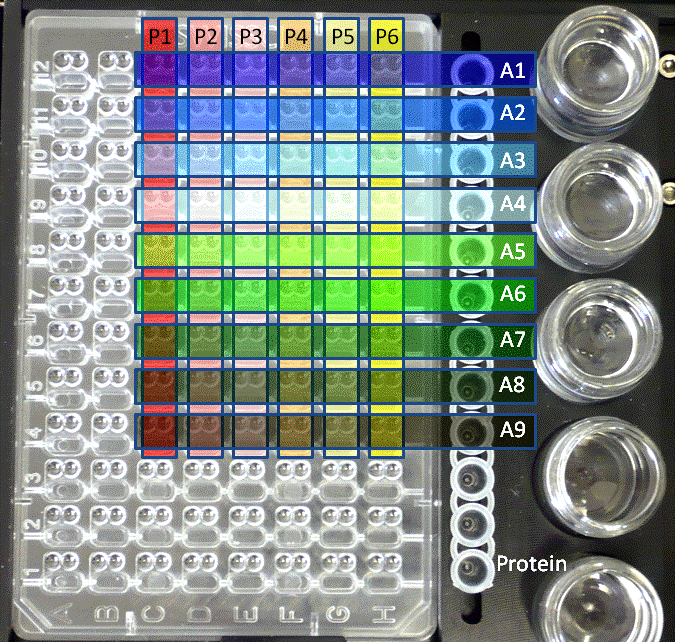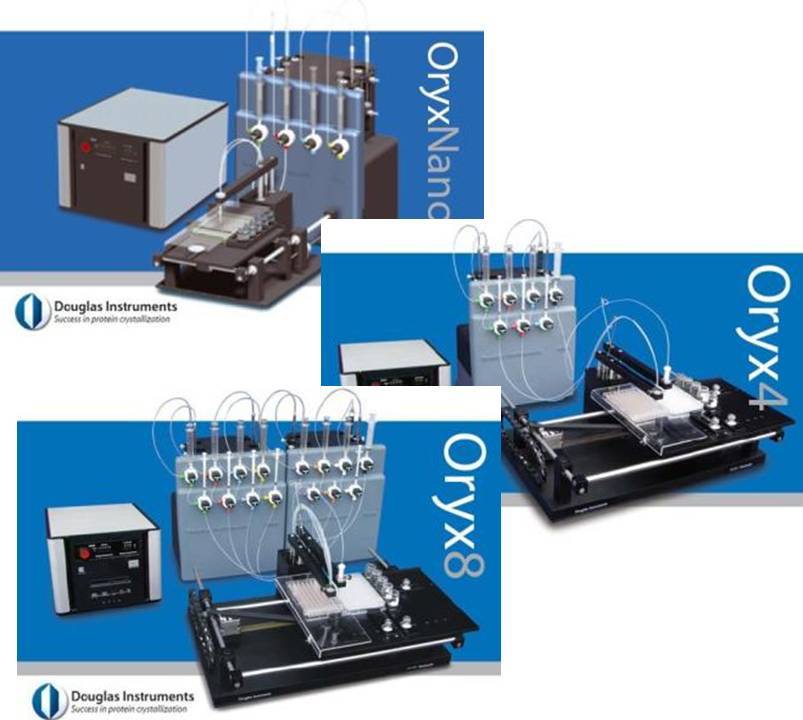From: Douglas Instruments [hilary1@douglas.co.uk]
Sent: 06 March 2012 14:49
To: Hilary McNeill
Subject: New from Douglas Instruments - Combinatorial Optimization
|
Click here to view this newsletter on the Douglas Instruments web site |
||||
A simple approach that can reshuffle the
ingredients from several crystallization hits
|
||||
|
|
||||
|
Imagine that you've run some
screens and found the crystallization hits shown on the left. Now, somehow,
you want to combine the ingredients of those three hits to get something like
the crystal shown on the right. |
||||
|
We've introduced a new script for
the Oryx
range of robots that can optimize crystallization by reshuffling the
ingredients from several hits. (It's useful for seeding and
ligand-binding experiments too - see below). |
||||
|
Say you've picked up needles or
small crystals in the following conditions: 1. 30 % v/v PEG4000, 0.2M MgCl2, 0.1M TRIS, pH 8.5 2. 28 % v/v PEG400, 0.2M CaCl2, 0.1M HEPES, pH 7.5 3. 1.0M Na acetate, 0.1M imidazole, pH 6.5 |
||||
|
Looking at these results, it's
hard to draw up a plan for optimization. Is the best precipitant PEG,
or a salt? If PEG, does the molecular weight matter? Are the
bivalent cations Mg2+ and Ca2+ important? And which pH is best? |
||||
|
Our new script allows the
precipitants to be dealt with separately from the other ingredients so that
they can be reassorted. For example the best crystals might come from
the high-lit ingredients above. |
||||
|
||||
|
Over the years we've heard how
successful "targeted" screens can be. The trouble was that
they were time-consuming to set up, and - until now - separate robots were
needed to make the screen and to set up the drops. The new Combinatorial
Optimization script is based on a simple idea, but it allows a
(systematic-type) targeted screen to be set up in 15 to 20 minutes. |
||||
The optimization of microseeding
|
||||
|
Note that the same approach can be
used for several other important experiments. For example, microseeding often
gives too many crystals. Using the script, seed
stocks with various dilutions can be added to one or more hit conditions.
(Typically a dilution series would be set up, running from the
"neat" seed stock to a 1:100,000 dilution.) The crystals below were
optimized by Laura Cendron using a similar approach. |
||||
|
|
||||
|
Crystals grown by Laura Cendron at the
University of Padova. Left, crystals used to make the seed
stock. Other images: crystals grown with seeding. |
||||
Other applications
|
||||
|
The same script can be used for
additive experiments. For example, up to 12 ligands or inhibitors can
be added to the twelve rows of the plate. |
||||
|
To request a demonstration in
your own lab, please contact Hilary@douglas.co.uk. Collecting data at Diamond
Light Source? We're located about 20 minutes from Diamond, and we'd be
happy to pick you up and demonstrate our systems in our lab. If you
take some protein samples with you, we can also set up some crystallization
trials for you, including microseeding and combinatorial optimization. |
||||
|
||||
|
|
||||
Douglas Instruments
|
||||
|
Douglas Instruments was founded in
1987 by Peter Baldock and Patrick Shaw Stewart. In 1989, in collaboration
with David Blow’s group at Imperial College (London), Douglas Instruments
developed their first system for automatic protein crystallization – the IMPAX.
The company moved in 1999 to Douglas House, about 25 miles South of Oxford,
where its Oryx range of protein crystallization systems has been developed. |
||||
|
Over 200
crystallization units have been installed since 1987 in universities,
research institutes and companies worldwide. Oryx systems offer versatile
solutions for protein crystallization and Douglas Instruments continues to
work closely with its customers to develop novel scientific techniques in
this area. We are always happy to hear from workers in the field, whether
they are customers or not. If you have any comments, questions or suggestions
please e-mail Hilary@douglas.co.uk
or Patrick@douglas.co.uk . |
||||
|
Here are some of the meetings in 2012 where we will be demonstrating the Oryx: Seventh International Workshop on X-ray Radiation Damage to Biological Crystalline Samples, Diamond Light Source, 14 - 16 March 2012. BCA Spring Meeting, University of Warwick, 16 - 19 April 2012 FEBS Advanced Methods in Macromolecular Crystallization, Czech Republic June 22 - 29, 2012 ACA Boston 28 - 31 July 2012 |
||||
|
To unsubscribe, click
here or send an email to: unsubscribe-40118@elabs5.com. |





